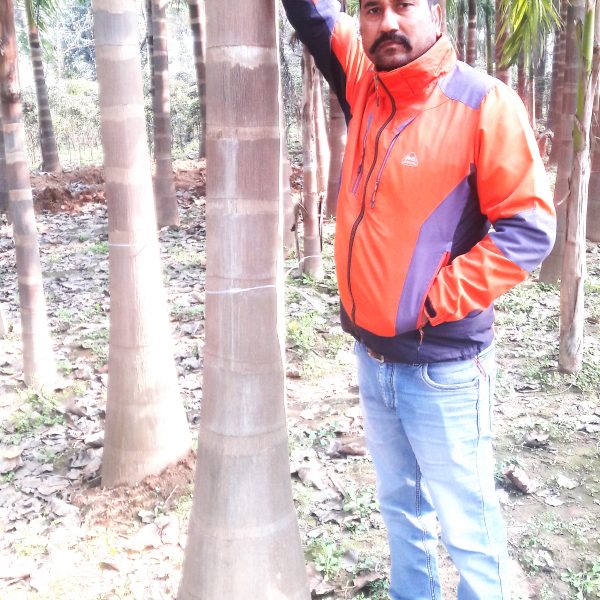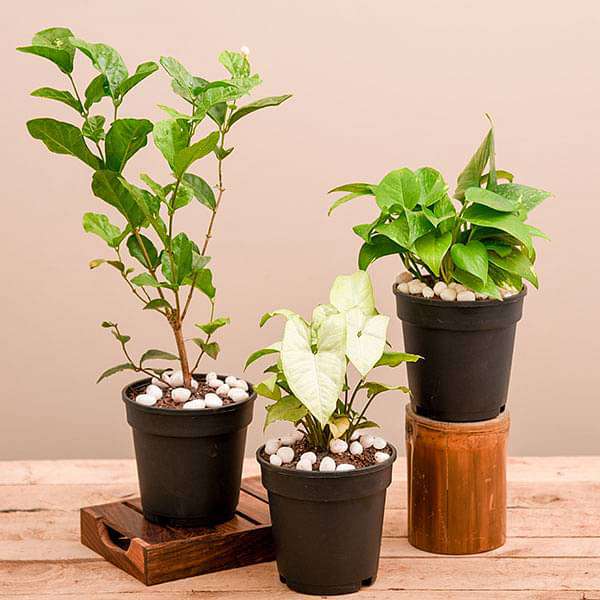Despite its common name, sago palm (Cycas revoluta) isn’t technically a true palm tree. These fairly low-growing plants with long green fronds are cycads, a group of ancient tropical and subtropical plants that usually grow from a trunk that doesn’t branch out; it produces nuts but doesn’t flower or fruit. Sago palms are native to warm parts of Japan and southern China.
In cooler climates, they’re often grown as houseplants. When grown in the garden, plant them in the early spring or late fall. These plants are extremely slow-growing, gaining only a few inches annually, and may only produce one new frond each year. Its feather-like foliage grows out in a symmetrical ring. Generally, they grow larger when planted in the ground versus when they’re in containers. After several years, they may reach 2 to 3 feet. Getting to its maximum of 10 feet can take as long as 50 years. The plant is toxic to humans and pets.12
| Common Name | Sago palm, king sago, cycad, Japanese sago |
| Botanical Name | Cycas revoluta |
| Family | Cycadaceae |
| Plant Type | Perennial shrub |
| Mature Size | 3–10 feet tall and wide |
| Sun Exposure | Full, partial |
| Soil Type | Sandy, moist, but well-draining soil |
| Soil pH | Acidic (5.5–6.5) |
| Bloom Time | Nonflowering |
| Flower Color | Nonflowering |
| Hardiness Zones | 9–10 (USDA); grown as houseplants in all zones |
| Native Area | Asia |
| Toxicity | Toxic to humans and pets |
Watch Now: How to Grow and Care for a Sago Palm
Sago Palm Care
Sago palms appreciate a warm and bright environment, though harsh sunlight can damage the foliage. They also like humidity, supplemented by misting them regularly with clean water from a spray bottle. You also can place the plant container on a tray filled with water and pebbles, as long as the bottom of the pot isn’t touching the water. Sitting water can cause root rot.
These plants are sensitive to overwatering and poorly drained soil. So make sure the soil surface dries out in between waterings. Choose a pot with ample drainage holes for container plantings. Many gardeners prefer to use unglazed terra cotta pots because excess soil moisture can evaporate through the porous pot.
:max_bytes(150000):strip_icc():format(webp)/grow-sago-palms-1902770-07-fa8ece3c2fd94cff9a1b78a07fa897c1.jpg)
:max_bytes(150000):strip_icc():format(webp)/grow-sago-palms-1902770-10-fa2eb417014e42c8b61427a142e1dc71.jpg)
:max_bytes(150000):strip_icc():format(webp)/grow-sago-palms-1902770-03-9ee2f3b9a72c4d98b5cf26c33aae7ce3.jpg)
Light
Sago palms prefer bright, indirect light. Avoid placing them in direct sunlight. The scorching afternoon sun can wilt and burn the foliage in the summertime, and too much shade can result in sparse leaves and an unhealthy plant. When grown indoors, choose a bright east-, west-, or south-facing window. Indoor plants can be moved outside in warm weather as long as the container is in dappled sunlight.
Soil
Sago palms aren’t overly picky about their soil, as long as they have good drainage. A sandy soil that’s somewhat rich in organic matter and slightly acidic to neutral soil pH is ideal. For container plants, a potting mix made for cactus or palms should be suitable.
Water
Sago palms have some drought tolerance, but they prefer a moderate amount of moisture in the soil. Water whenever the soil feels dry to the touch, making sure never to overwater to the point of soggy soil. Slightly reduce watering in the winter when the plant is not actively growing.
Temperature and Humidity
These plants love warm, humid conditions. They can briefly tolerate cold temperatures, but frost can damage the foliage, and temperatures below 23 degrees Fahrenheit will likely kill the plant. When grown indoors, protect your sago palm from drafts and airflow from heating and air-conditioning vents; extreme temperature fluctuations can damage the plant.
Fertilizer
Fertilize monthly throughout the growing season (spring to fall) with a liquid fertilizer, using an 18-8-18 ratio (nitrogen-phosphorus-potassium), mixed according to the package directions. You can also use slow-release fertilizer two to three times during the growing season, following package instructions. To calculate how much fertilizer you need, figure you will need about 1 1/2 pounds of sago palm fertilizer for every 100 square feet of ground. If your sago is planted in clay, a less porous medium, you will need half the amount of fertilizer. It’s best to fertilize right before a rain shower, which helps distribute the plant food.
Types of Sago Palm
Other plants use the common name of sago palm, though Cycas revoluta is the most widely cultivated. The other species include:
- Cycas rumphii (queen sago): Grows more like a tree than a shrub, reaching about 15 feet tall
- Cycas circinalis (queen sago palm): Tree-like, reaching nearly 10 feet tall, and is native to India
- Metroxylon sagu (true sago palm): A true palm and is part of the botanical family that contains other popular palm trees
Pruning
Only prune sago palm when the leaves have turned completely brown. Keep yellowing leaves intact. They may not look pretty, but they are still absorbing nutrients for the plant. Removing yellowing leaves may spur further yellowing and worsen the plant’s health. If you must remove some of the fronds, the safest to cut away are those along the bottom circumference of the plant. Using sterilized pruning shears or hand pruners, cut them as close to the trunk as possible.
Propagating Sago Palm
Palm propagation typically occurs by planting seeds. But this process takes longer and is often ineffective. Propagation by division is the quicker and easier way to go. Sago palm develops pups or offsets that look like baby plants that grow in clusters at the base of the plant. Separating the pups from the parent plant alleviates crowding, competition for water, and promotes more air circulation around the plant base. The best time to transplant those pups is early spring or late fall. Here’s how to cultivate the offsets:
- If you have a sago palm with offsets or baby offshoots, you can divide the plant. You will need a hand trowel, knife, or scissors; a container; and well-draining soil suitable for palm trees. Sterilize the tools with an alcohol- or bleach-based solution before use.
- Some offsets are loosely attached and are easily removed with a tug, or you might need to use your scissors, a knife, or a hand trowel to pry or cut off the offset.
- Place the offset on a tray for a few days in a shady spot to allow the cut to dry and callous over. The callous helps keep diseases away from the plant.
- Fill a pot partially with well-draining soil. The pot should only be about 2 inches larger than the circumference of the offset, and the pot should have about two inches of growing room at the bottom too. Center the offshoot in the pot and fill in the sides with potting soil. Water thoroughly.
- Place the plant in a sunny location indoors or a shady spot outside. It should take a couple of months for rooting to occur. Allow the plant to dry out between waterings.
How to Grow Sago Palm From Seed
Sago palm seeds can be either male or female. It doesn’t matter which one you have; either will grow into a plant as long as the seeds come from a reputable source. Sago palms are bright red to orange-hued. The seeds contain toxins, so wear gloves when handling them. To prepare the seeds, soak them in room temperature water to soften them and remove the outer husk. Plant them in a shallow seed starting tray or pot. Cover the seeds with a sand-based seed starting mix and place them in a warm spot. Keep the soil moist as you wait for the seedling to emerge. Like many large seeds, be prepared to wait patiently. Sago palm seed germination can take several months.
Potting and Repotting Sago Palm
Because they grow slowly, sago palms only need repotting every three years or so. It’s a good idea to gently remove the plant from its pot every spring and replace the loose soil with fresh soil to ensure continued healthy growth. This plant grows best in a soil-based potting mix amended with sand and peat moss.
Only repot or transplant new pups inground if they have formed extensive root systems. Newly planted sagos should only be moved during early spring, and mature palms can be transplanted during early spring or late fall.
Sago palms do not like wet, soggy soil, so opt for an unglazed ceramic or terra cotta pot. The porous material will help absorb excess moisture from the soil. Also, choose a pot with multiple drainage holes to allow the water to drain easily.
Overwintering
Sago palms are hardy up down to zone 8. They can handle brief temperature snaps at 15 degrees F but die when kept at 23 F or below. To prevent plant death, provide winter protection. If you can’t take the plant indoors, then cover the plant with a burlap bag or lightweight blanket during a short cold snap. Uncover the plant when the frost melts away the next day.
Common Pests
Sago palms don’t have serious issues with pests or diseases. But scale and spider mites can become problematic. Look out for foliage damage or discoloration, as well as tiny bugs among the fronds. Aim to use an organic insecticide like insecticidal soap or neem oil before turning to harsher chemicals, and make sure your plant has enough humidity and airflow.
Common Problems With Sago Palm
Sago palms are easy to grow and maintain, but they require specific growing conditions to keep them healthy. Often small changes like watering schedule, checking water drainage, and the correct soil type can go a long way.
Yellowing Leaves
Yellowing is common in older, outer leaves and can be attributed to the life cycle of that leaf. The bottom-most, lower ring of leaves are the oldest. Do not remove the leaves until they turn brown and die.
Insects can also cause yellowing, and if you haven’t noticed any bugs on the plant, you can suspect a manganese deficiency in the soil. The yellowing will appear to affect all of the fronds. You can apply manganese sulfate powder to the soil two to three times annually to correct the problem. Yellowed leaves won’t turn green, but subsequent foliage should look healthy.
Wilting Leaves and Leaf Drop
Root rot is a fungal infection often caused by too much water or using poorly draining, compacted soil. The fungus gets to the roots and destroys the plant from within. Another sign of root rot is an oozing, black sore or stain on the trunk. Root rot results in leaf wilt, discoloration, and leaves falling out. If you catch it early, you can remove infected foliage and treat the plant with a fungal spray or systemic fungicide. You might be able to save the plant. If the plant has lost too many leaves, it may be too far gone to salvage, but it’s worth a try.
Little Black Spots on Foliage
Even if your plant has recovered from an insect strike, you might notice small black spots that look like dirt or soot on leaves or stems. Sooty mold is a fungus that grows on the secretions that tiny bugs leave behind. This fungus can be washed off the sago’s leaves with a steady stream of water on each spot. The fungus will not feed on the sago, but it will grow if left unchecked and can overtake a plant’s leaves, affecting chlorophyll production and photosynthesis.







Reviews
There are no reviews yet.